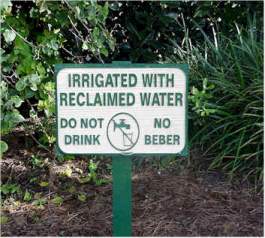Reclaimed water for gardening

 Question from Karen:
Question from Karen:
I’m having a reverse osmosis filtration system installed in my kitchen. To produce it 3 gallons are needed to produce 1 gallon of filtered water. Ideally I’d like to recycle and reuse the excess water.
Do you know anyone who has done this or do you have any information about whether this would work as a supplement to garden water? I’ve searched this topic on line but haven’t found anything of much use.
Clearly I don’t raise orchids or other exotics–just the most usual Del Mar plants.
Many thanks for any advice you may have.
Answer from Pat:
I have had one of these filtration systems in my home for many years and I would never use waste water from it to water houseplants, nor would I used softened water for houseplants since it contains more alkalinity than regular water. However, you can use softened water for houseplants if you treat it first with gypsum. To make artificially softened water safe for watering houseplants, mix 1/2 teaspoon of gypsum per gallon of water. In most cases this is enough calcium to replace the calcium lost in the softening process. I would, however, and do use filtered water for watering houseplants since this contains less alkalinity than regular water and thus is better for plants. Since I drink bottled spring water, mainly my system feeds the ice machine in my refrigerator.
In most cases reverse osmosis systems are devised so that the water used to produce the filtered drinking water simply flows down down the drain from the kitchen sink. This water naturally is going to contain more salts than normal tap water. It also will contain any impurities, such as heavy metals, that the original tap water contained. As I stated above, cold tap water is fine to use for watering houseplants, but I would not want to use waste water from a reverse osmosis machine for watering house plants because it contains more of these salts and impurities that are bad for plants. If you use it for garden plants it would also contain more salts than normal water and thus might burn the tips of leaves. Our tap water is hard alkaline water and this water will be even harder. Plants don’t like alkaline water but the level of alkalinity in ordinary tap water usually doesn’t add enough salt to the ground to permanently harm plants since annual rains wash these salts away.
The method for recycling waste water is to re-route the drain water that comes from the kitchen sink and from the laundry. There are several ways to do this and many books on the subject that you can find at the local library or at a book store. Municipalities have also established health laws on gray water. Before hooking up such a system be sure to investigate the gray-water laws in your town and make sure there are no regulations against the subject. There are at least two possible ways to use gray water in your garden. One method is to route the gray water into a barrel and then hook the barrel up to a hose that can work by gravity or by a pump. Another way is to route it straight into a drain line instead of the sewer. This is the way all waste water in our town was originally routed. In most cases the water first went into a septic tank to drain out solids which eventually liquified and after the septic tank the water then was piped into a cess pool sometimes a drain line was also added to water trees or other landscaping. However, after the sewer system was installed most homes eventually hooked up to the sewer.
Gray water has some problems. Gray water may contain impurities that could lead to disease which is why towns have regulations. Gray water is also alkaline and contains soap which eventually can bind up soils but also has phosphorus in it which is a fertilizer. When using gray water, the accepted method to counteract alkalinity is to mix gypsum with the gray water in order to combine with the salts and so the salts don’t bind together the particles in the soil. The aim is to prevent the water from making garden soil, such as clay particularly, from becoming coated with soap and eventually more impermeable than it already is. Grease also can be a problem building up in soil. One also needs to realize that anything you are putting on the ground will eventually filter through the ground, the drains, and into the ocean carrying with it any impurities. We need to be aware of runoff and not add impurities to the ground that can eventually end up in the ocean. Throughout the world fertilizers ending up in oceans cause negative effects on coral reefs and ocean floors, leading to blooming of algae and other effects that upset the natural balance of nature in the sea and can harm dolphins, fish, and other sea creatures.


Much appreciated! What a comprehensive review. You are the best.
I did what you suggested I phoned our city hall and found out that dispersal of gray water in the town where I live now has stringent regulations and a permitting process–one can no longer run the wash water out into the garden. I imagine that is for the best in terms of public health but also because I live in a coastal village and thus what we put on the ground soon ends up in the ocean.